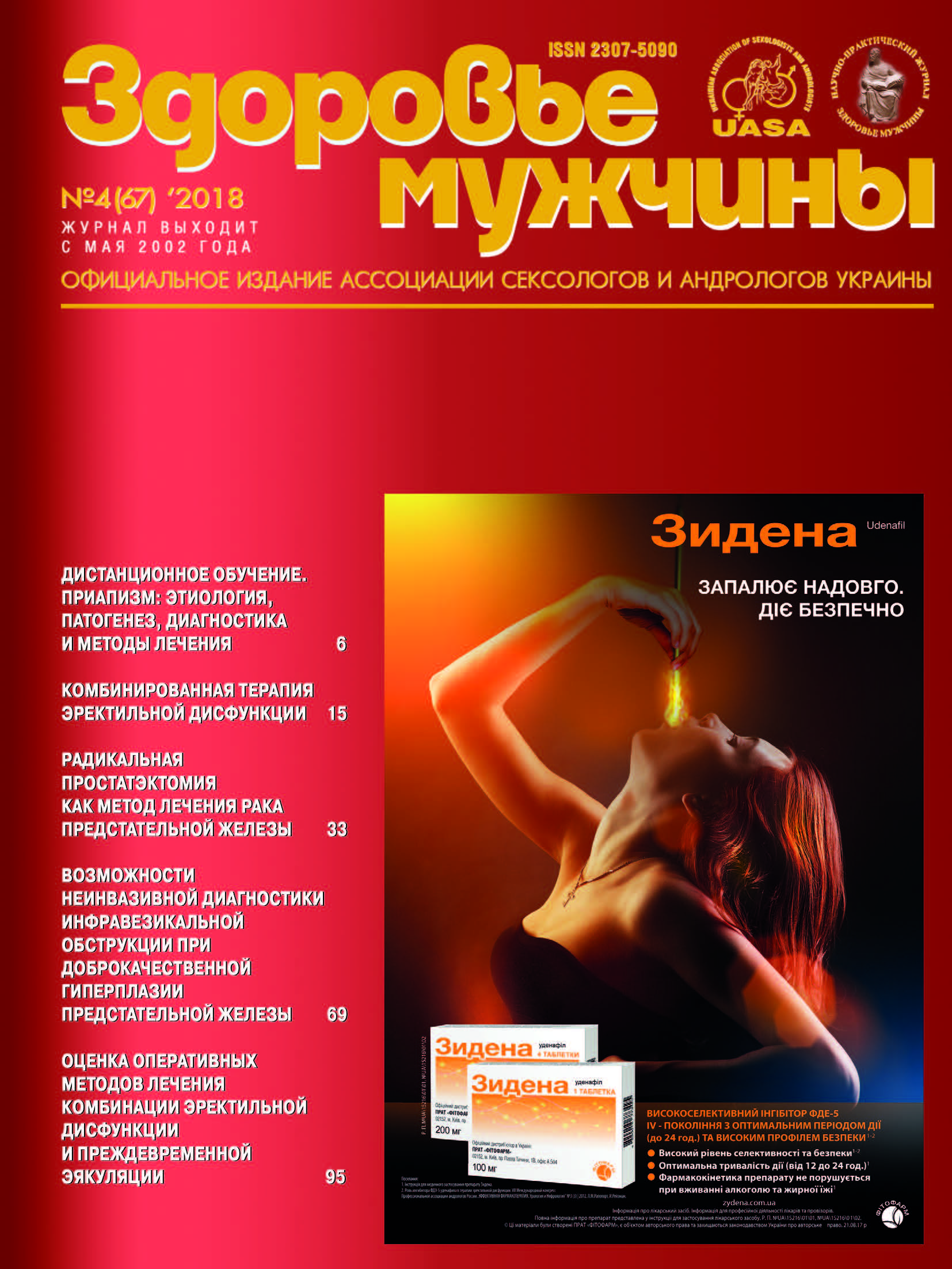Combination Therapy for Erectile Dysfunction
##plugins.themes.bootstrap3.article.main##
Abstract
The objective: to evaluate the efficacy and safety of using hormone replacement therapy with testosterone in combination with iFDE-5 (udenafil) in the treatment of erectile dysfunction (ED) in men with androgen deficiency associated with type 2 diabetes mellitus (DM).
Materials and methods. The study involved 20 patients with type 2 diabetes and signs of ED on the background of secondary hypogonadism. Before treatment, patients underwent a standard clinical examination in a urological hospital, after which they were equally divided into two groups using a «tossed coin». Patients of group I (n = 10) received testosterone HRT at a dose of 50 mg / day for 12 weeks, patients of group II (n=10) used testosterone hormone combined with udenafil (100–200 mg/day twice and more than once a week) also for 12 weeks.
Results. It was proved that after 12 weeks of therapy, the level of total testosterone in the combination therapy group increased from 6.6±1.3 to 17.1±4.2 nmol/ml, while in the monotherapy group the changes were less pronounced – from 5,6±1.2 to 13.3±2.3 nmol/ml. An important indicator for patients with type 2 diabetes – glucose level – also showed significant changes in the combination therapy group: from 10.2±2.7 to 6.9±1.6 mmol/l compared with the results of the monotherapy group: from 9,9±2.4 to 8.1±1.5 mmol/l.
Conclusion. Erectile dysfunction therapy in men with androgen deficiency in patients with type 2 diabetes with hormone replacement therapy with testosterone in combination with phosphodiesterase-5 inhibitor (udenafil) can be an effective alternative to traditional hormone replacement therapy, but further research is needed in this direction.##plugins.themes.bootstrap3.article.details##

This work is licensed under a Creative Commons Attribution 4.0 International License.
Authors retain the copyright and grant the journal the first publication of original scientific articles under the Creative Commons Attribution 4.0 International License, which allows others to distribute work with acknowledgment of authorship and first publication in this journal.
References
Johannes C.B., et al. Incidence of erectile dysfunction in men 40 to 69 years old: longitudinal results from the Massachusetts male aging study. J Urol, 2000. 163: 460–3. https://doi.org/10.1016/S0022-5347(05)67900-1
Schouten, B.W., et al. Incidence rates of erectile dysfunction in the Dutch general population. Effects of definition, clinical relevance and duration of follow-up in the Krimpen Study. Int J Impot Res, 2005.17:58–62. https://doi.org/10.1038/sj.ijir.3901264
Salonia A., et al. Is erectile dysfunction a reliable proxy of general male health status? The case for the International Index of Erectile Function-Erectile Function domain. J Sex Med, 2012. 9: 2708–15. https://doi.org/10.1111/j.1743-6109.2012.02869.x
Buvat J., et al. Endocrine aspects of male sexual dysfunctions. J Sex Med, 2010.7:1627–56. https://doi.org/10.1111/j.1743-6109.2010.01780.x
Jackson G., et al. Cardiovascular aspects of sexual medicine. J Sex Med, 2010.7:1608–26. https://doi.org/10.1111/j.1743-6109.2010.01779.x
Besiroglu H., et al. The relationship between metabolic syndrome, its components, and erectile dysfunction: a systematic review and a meta-analysis of observational studies. J Sex Med, 2015.12:1309–18. https://doi.org/10.1111/jsm.12885
Kapoor D., et al. Clinical and biochemical assessment of hypogonadism in men with type 2 diabetes: correlations with bioavailable testosterone and visceral adiposity. Diabetes Care, 2007.30:911–7. https://www.ncbi.nlm.nih.gov/pubmed/17392552 https://doi.org/10.2337/dc06-1426
Dhindsa S., et al. Frequent occurrence of hypogonadotropic hypogonadism in type 2 diabetes. J Clin Endocrinol Metab, 2004.89:5462–8. https://doi.org/10.1210/jc.2004-0804
Ding E.L., et al. Sex differences of endogenous sex hormones and risk of type 2 diabetes: a systematic review and metaanalysis. Jama, 2006.295:1288–99. https://doi.org/10.1001/jama.295.11.1288
Binmoammar T.A., et al. The impact of poor glycaemic control on the prevalence of erectile dysfunction in men with type 2 diabetes mellitus: a systematic review. JRSM Open, 2016.7:2054270415622602. https://doi.org/10.1177/2054270415622602
Kalinchenko S.Y., et al. Oral testosterone undecanoate reverses erectile dysfunction associated with diabetes mellitus in patients failing on sildenafil citrate therapy alone. Aging Male, 2003.6:94–9. http://dx.doi.org/10.1080/tam.6.2.94.99
Spitzer M, et al. Sildenafil increases serum testosterone levels by a direct action on the testes. Andrology, 2013.1:913–918. https://dx.doi.org/10.1111%2Fj.2047-2927.2013.00131.x





